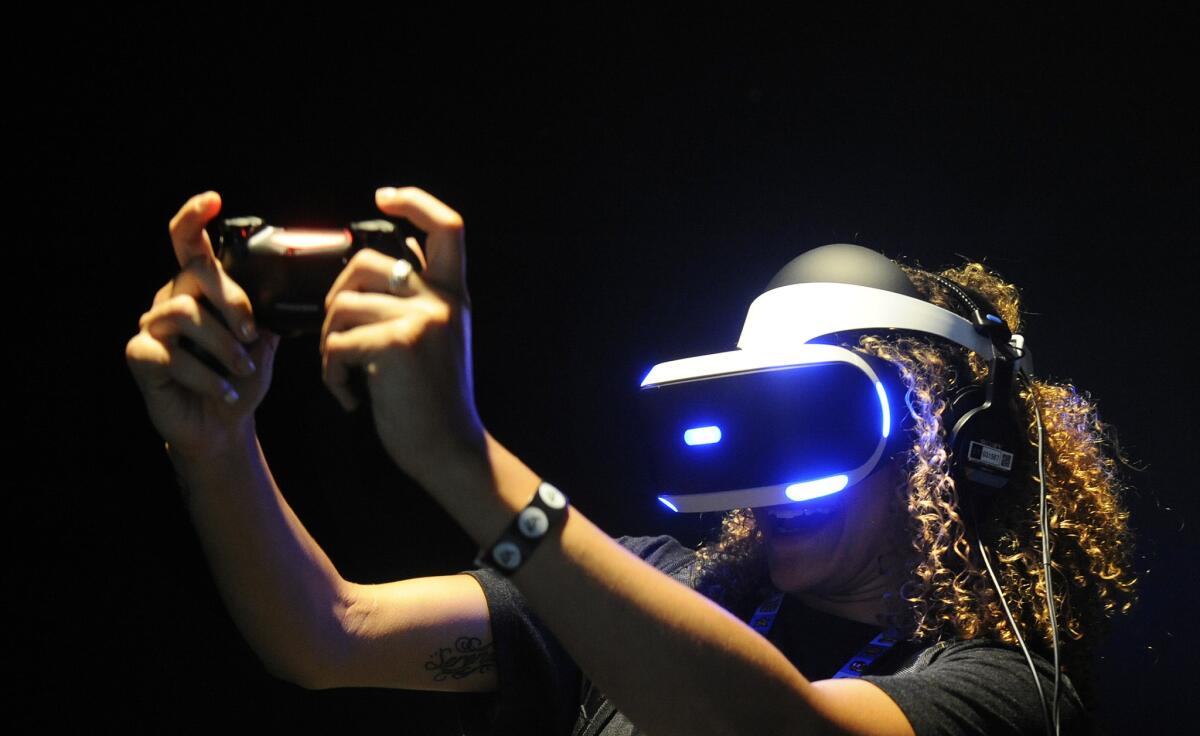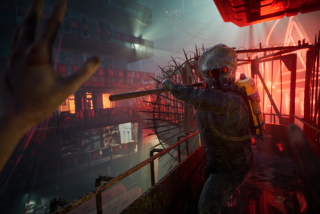The Player: Video game trends for 2016: Virtual reality, further blurred lines between TV and gaming

Sianna Hasenberg plays with Sony’s PlayStation VR at the Electronic Entertainment Expo in 2015. The headset is due for release in 2016.
Of all the mainstream forms of pop art, perhaps only in interactive entertainment can a game be a success before it has even been released. For here is a medium that is still growing, both in the types of content available as well as the technology.
The year ahead will bring us titles that tackle cancer, abandonment and unlikely friendship bonds, among other topics. They will take us to new galaxies. In “No Man’s Sky,” players will become explorers of uncharted solar systems, able to land on a dizzying number of planets filled with colorful new life forms. Next holiday season, “Mass Effect: Andromeda” will be the latest in an epic space series in which personalities have mattered as much as guns.
More unconventionally, some will seek to further blur the lines between television and gaming, as games today increasingly emphasize narrative elements.
SIGN UP for the free Indie Focus movies newsletter >>
The new games will be judged not just on their technical prowess. No longer is some alchemy of bits and bytes a recipe to instant, magical game success. Today, a title like “That Dragon, Cancer,” due Jan. 12, can score a win simply by showing the unassuming how games can breach previously off-limits topics of conversation. Cancer, in a child no less? Sure. Games can handle that.
There will, of course, be no shortage of impressive new hardware, from virtual reality headgear to the reveal of a new Nintendo console. Worth watching too is how independent developers began to tinker with the just-released Apple TV, an accessible game console in disguise. Like Nintendo’s Wii before it, Apple TV offers the promise of appealing to those overwhelmed by the current complexity of console hardware.
Most of the focus, however, will be on 2016’s shiny new toy: virtual reality.
Though we’ve recently seen entries and experiments in the virtual mobile space, 2016 is expected to be the year when VR finally goes mainstream. Since Nintendo released its Virtual Boy in the mid-’90s, VR has consistently felt on the verge of something great. Thus, having been the next big thing on more than one occasion, it’s worth viewing the latest VR overtures with a hint of skepticism.
And yet, what a delight it was to demo “Lucky’s Tale” on the PC-friendly Oculus Rift earlier this year, a cartoonish game in which a fox, Lucky, traverses a candy-colored universe.
Never mind that the game’s task at hand — simply looking and hopping around a fully vibrant and digitized world, one where treehouses and bridges sprouted before me — was a joy. It reminded me of seeing “Who Framed Roger Rabbit” as a youngster, the first time it seemed possible that an animated universe could intermingle with our own.
More tense was “Edge of Nowhere,” in which I slowly navigated icy tundra to avoid dangerous, mystical creatures. If I wasn’t exactly transported to the arctic, by wearing the VR goggles I was fully closed off from the outside world, allowing myself to completely give in to an immersive game.
These, and other such titles, impress in short demos, but will they be as fun in the confines of a home, where daily life has a way of intervening?
It’s unclear, for instance, if the Rift, as well as Sony’s PlayStation VR, the latter to be used with the PlayStation 4, have fully solved some of VR’s long-held problems. In The Times’ 1996 review of Nintendo’s Virtual Boy, for instance, we noted it came with a high “migraine factor” and was far from social, problems that persist today. Sony has shown a possible solution for the latter, as some of its headset games will allow the whole family to play, as those not wearing the goggles can interact with the old-fashion television screen.
Other VR proponents argue that the format is the most social form of gaming yet, at least when each player has a headset and can appear to reach out and touch the other. But expect the first crop of games — and players — to be something of test subjects, to offer a glimpse as to how much of a reality VR can come, if not this year, then in the years to come.
Plan to spend about $1,500 for an Oculus Rift and a Rift-powered PC (a Rift on its own will probably set you back a few hundred), a price point that may put it out of reach for many. Alternatively, those enticed by Sony’s PlayStation VR will need to either own or invest in the company’s PlayStation 4. Sony has yet to reveal a price point for its headset. While VR will arrive in a big way in 2016, perhaps it’s best to consider it a toy at first for the most elite level of players.
When it comes to enticing more casual gamers to enter the game space, eyes once again will likely be on Nintendo. The company, looking to rebound from its poor-selling Wii U, will unveil its next piece of hardware, tentatively dubbed the NX. What form it will take is unknown, but Nintendo has a cadre of characters with household names (Mario, Link, Donkey Kong and more), as well as a willingness to experiment (see the motion-controlled Wii or the touch-screen-enhanced Wii U).
Additionally, with Nintendo finally entering the mobile game space in 2016, expect its top-flight brands to begin to resonate with a new generation of consumers, mainly those growing up with mobile devices as their core gaming unit. The Wii U may be a distant third to Sony’s PlayStation 4 and Microsoft’s Xbox One, but titles like “Super Mario Bros.” and “The Legend of Zelda” have proved to be timeless, and Nintendo has a knack for reinventing itself.
But what will we be playing? Early in 2016 we’ll get the what looks to be a gripping “Adr1ft,” in which a woman is lost in space after an accident left all of her co-workers dead, as well as the latest from adventurous indie designer Jonathan Blow, “The Witness,” a game in which an entire island becomes a puzzle.
Sony’s Naughty Dog will return with “Uncharted 4: A Thief’s End,” a game that appears to continue the studio’s quest to marry bombs and bombast with cinematic-like seamlessness. Naughty Dog’s most recent work, 2013’s “The Last of Us,” remains a modern landmark for bringing character depth to digital gunplay. It broke up the action with quiet, conversational moments, creating people we wanted to save rather than inhabit.
While “Uncharted 4” is a PlayStation 4 exclusive, Xbox One owners can look ahead to “Quantum Break,” a combination game/television series. Moments in the game will trigger episodes of “Quantum Break” the show, and if all goes according to plan, the show will offer suggestions to the player on which path to take in the game. If it works, games could tap a new audience of nonplayers.
Nintendo, finally, plans to release a Wii U take on “The Legend of Zelda,” and Sony is promising the long-awaited “The Last Guardian,” a game in which a young boy befriends a giant creature with puppy-like cuteness. Plenty of recognizable franchises will return — “Dishonored,” “Mirror’s Edge” and “Fire Emblem” among them — but 2016 will also be a time to get to know new characters.
Few, perhaps, look to be as unexpected or as charming as Yarny, a character wound together with yarn who explores backyard neighborhoods. Brought to life by an elderly woman, Yarny runs and jumps across a naturalistic world to discover one person’s lost memories. “Unravel” is not just a game about how a yarn-constructed creature can survive some rocky ponds; it’s a tale about how life can become undone.
It’s games such as “Unravel,” as well as “That Dragon, Cancer” and even the bulk of work from Naughty Dog, that continue to push games to challenge not just players but our perception of the medium.
Here’s a prediction: Regardless of what new technology brings, play by the end of 2016 will no longer be regarded as a pure leisure time distraction.
More to Read
The biggest entertainment stories
Get our big stories about Hollywood, film, television, music, arts, culture and more right in your inbox as soon as they publish.
You may occasionally receive promotional content from the Los Angeles Times.











